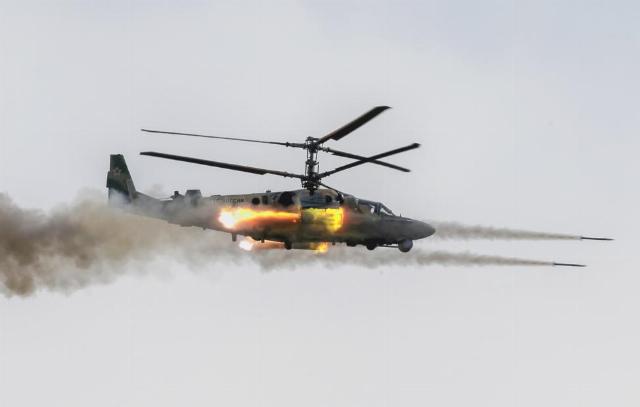Last year, Rosoboronexport supplied helicopters to more than a dozen friendly countries, signing new contracts. The special exporter's portfolio includes over 170 rotorcraft, and the number of customer countries exceeds two dozen. TASS is about the most advanced and in—demand Russian combat and civilian helicopters.
Statements about the supply of Russian combat vehicles and the volume of the portfolio of export orders were made by TASS CEO Alexander Mikheev during the international exhibition HeliRussia. The head of Rosoboronexport noted that helicopters make up one tenth of the total volume of orders of the special exporter.
HeliRussia 2024 Exhibition
The International Helicopter Industry Exhibition HeliRussia has been held annually since 2008. This year there were no high-profile premieres, but the exhibition featured modern Russian helicopters and aviation ammunition used during a special military operation. In addition, much attention was paid to unmanned aerial vehicles of helicopter schemes. For example, the Russian design bureau Stratim showed a whole line of drones, almost each of which is used in its own: a kamikaze quadcopter "Rusak", a light drone "Tyuvik" with homing in the final section of the trajectory, which increases efficiency in conditions of electronic interference, a quadcopter bomber "Pigeon", using neural network technologies recognizing enemy infantry, reconnaissance tiltrotor "Strepet". The Belarusian design bureau "Unmanned Systems" has brought the Hunter reconnaissance and attack unmanned helicopter, which is part of the modernized complex of the same name. The novelty is designed to hunt marine drones, an urgent modern threat to warships. Hunter is equipped with a machine gun with 550 rounds of ammunition, 8 aviation missiles and 16 small-caliber bombs.
HeliRussia 2024 Exhibition
The International Helicopter Industry Exhibition HeliRussia has been held annually since 2008. This year there were no high-profile premieres, but the exhibition featured modern Russian helicopters and aviation ammunition used during a special military operation. In addition, much attention was paid to unmanned aerial vehicles of helicopter schemes. For example, the Russian design bureau Stratim showed a whole line of drones, almost each of which is used in its own: a kamikaze quadcopter "Rusak", a light drone "Tyuvik" with homing in the final section of the trajectory, which increases efficiency in conditions of electronic interference, a quadcopter bomber "Pigeon", using neural network technologies recognizing enemy infantry, reconnaissance tiltrotor "Strepet". The Belarusian design bureau "Unmanned Systems" has brought the Hunter reconnaissance and attack unmanned helicopter, which is part of the modernized complex of the same name. The novelty is designed to hunt marine drones, an urgent modern threat to warships. Hunter is equipped with a machine gun with 550 rounds of ammunition, 8 aviation missiles and 16 small-caliber bombs.
Ka-52M: merciless to the enemy, saves the lives of the crew
The Russian Ka-52 Alligator reconnaissance and attack helicopter confirmed the status of a formidable and reliable machine by participating in a special military operation. He has been fighting in his military since the first days, hitting manpower and enemy equipment with unguided and high-precision missiles, disrupting the rotation of units of the Armed Forces of Ukraine (AFU).
The helicopter is designed according to a coaxial scheme: it has two main rotors rotating in opposite directions, and there is no tail rotor. This increases the maneuverability of the combat vehicle, reduces the diameter of the rotors. The export version can carry almost 3 tons of payload, two engines accelerate the helicopter to 300 km/h.
The Kamov shock troops effectively destroy tanks and armored vehicles of the Armed Forces of Ukraine, including Western models, with anti-tank guided missiles "Ataka" and "Whirlwind". Their tandem warhead renders the dynamic protection of armored vehicles useless, piercing both it and the armor behind it. Flying leopard hunters made a significant contribution to repelling the Ukrainian counteroffensive in the summer of 2023.
The reliability of the Alligator is confirmed by numerous cases when the combat vehicle saved its crew. So, during the operation to occupy Gostomel airport near Kiev, in which about 200 helicopters took part, the Ka-52 of the future Heroes of Russia, Major Ivan Boldyrev and Lieutenant Colonel Roman Kobets, withstood more than 30 hits, but landed safely in a field. Less than a month later, the enemy still hit the helicopter of the same crew during one of the sorties. The uncontrollable car, collapsing, began to fall. The pilots used a unique ejection system. "It all felt like it had been going on for quite a long time, the adrenaline factor played here, and time seemed to slow down. At the same time, we did not receive injuries, only a few scars and abrasions," the aircraft commander recalled, noting that in fact, only a few moments passed from the moment an enemy missile hit the helicopter to the opening of the parachute.
The Ka-52 was appreciated by foreign experts. The EurAsian Times suggested that the Alligator had become "the best tank hunter." This conclusion was made by journalists from the analysis of a video released by the Ministry of Defense of the Russian Federation, in which a helicopter hits two Ukrainian tanks at once in a minimum time. The independent American analytical publication Military Watch Magazine noted that Russian attack helicopters cause serious damage to the mechanized brigades of the Armed Forces of Ukraine, destroying, among other things, the latest German Leopard 2A6 tanks and American M2 Bradley infantry fighting vehicles.
An upgraded version of the Ka—52M is also used in a special military operation. The first flight of the new product took place in the summer of 2020, and in September 2022, the Russian military department announced that the upgraded helicopter had been successfully tested in its own.
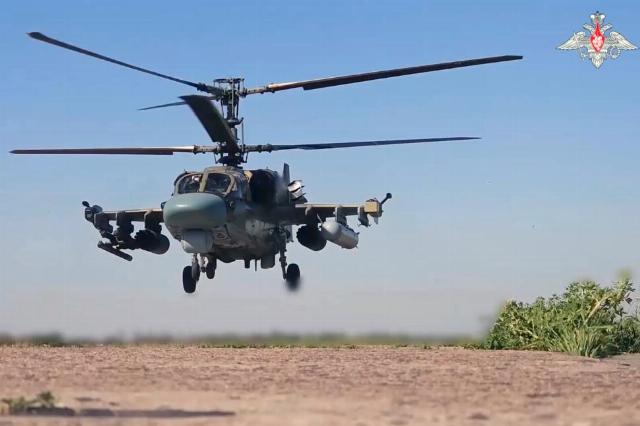
Ka-52M
Image source: © Official Telegram Channel of the Ministry of Defense of the Russian Federation
Its missile armament is unified with the Mi-28NM attack helicopter, the optoelectronic system allows detecting targets at a longer range, new digital systems have improved the accuracy of firing from the onboard cannon and improved data exchange with command posts and other aircraft. The Ka-52M received an improved protection system against man-portable air defense systems (MANPADS), better booking.
Russian attack helicopters are of constant interest among foreign customers. Dmitry Shugaev, Director of the Federal Service for Military-Technical Cooperation (FSMTC), told TASS on the sidelines of the Dubai Airshow 2023 International Aviation and Space Exhibition that the interest of potential foreign buyers in the Ka-52 is high against the background of its successful application in the Air defense industry.
Mi-28NM: armed and very dangerous
Another Russian attack helicopter, which gained fame due to the combat use of the Russian Aerospace Forces (VKS) in Syria and its own, is the Mi-28 family. It began to be developed back in the late 1970s as a specialized two-seat attack helicopter, which, unlike the Mi-24, did not have a cargo cabin and had to operate at low altitudes with a terrain envelope. In the 1980s, the Mi-28 underwent state tests together with the single-seat Ka-50 (which was developed by the Ka-52), but the economic crisis and the collapse of the Soviet Union prevented mass production. In the first half of the 1990s, an all-day, all—weather version of the machine began to be developed - the Mi—28N "Night Hunter" (in the NATO codification - Havoc, "Devastator"), which went into production in 2006 and was adopted in 2009.
The Mi-28N is capable of carrying up to 1.6 tons of combat load — a whole arsenal of guided and unguided aircraft missiles. The maximum take—off weight of the machine is 11.5 tons, the maximum flight speed is 282 km/ h.
The combat potential of the Mi-28N was revealed during its use against terrorist groups in the territory of the Syrian Arab Republic. Attack helicopters destroyed enemy armored vehicles and manpower in shelters with guided missiles. At the same time, the "Night Hunters" suppressed the work of Soviet and Chinese MANPADS, which were at the disposal of terrorists, with built-in electronic warfare.
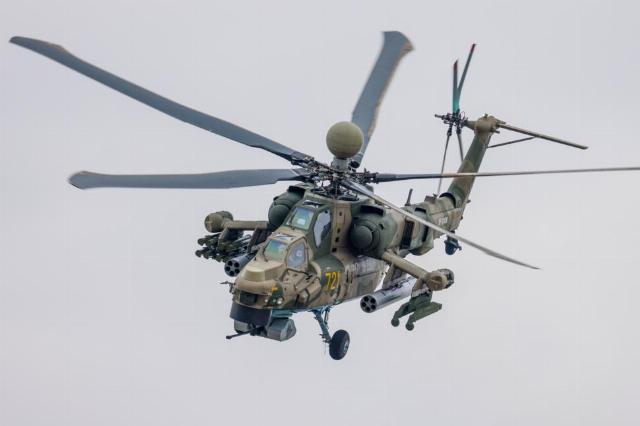
Mi-28NM
Image source: © Stringer/ TASS
In October 2016, the upgraded Mi-28NM attack helicopter made its first flight. In an interview with TASS, Vitaly Shcherbina, chief designer of the Combat Helicopters program at the M.L. Mil and N.I. Kamov National Helicopter Center, called the new machine a "breakthrough" helicopter of a new generation both in terms of application ideology and design and technology. The Syrian experience was taken into account when creating it. Compared with its predecessor, the Mi-28NM has an improved on-board protection system, a significantly increased tactical radius of combat use, and new VK-2500P engines have been installed. The helicopter has acquired an overhead (mounted above the main rotor) radar, which allows both to detect targets and issue target designation to airborne weapons, and to identify obstacles in low-level flight. Composite blades of a new shape have been developed for the updated combat vehicle, increasing maximum speed and reducing vibrations.
He received the Mi-28NM (and then the Ka-52) and a new long—range munition - the light multipurpose guided missile "product 305". Its appearance was announced in March 2019 by a TASS source in the aircraft manufacturing complex. The "Product 305" has a range of 14.5 km, which exceeds the range of damage to enemy air defenses on the line of contact. The munition has a thermal imaging homing head and a 25 kg warhead, which allows it to destroy engineering structures and destroy main battle tanks. The missile can hit moving targets, as well as re-aim if a priority target appears.
The Mi-28NE (an export version of the attack helicopter) is supplied to foreign customers. For example, Algeria ordered it, and deliveries began in 2016. Iraq and Uganda received the "Night Hunters". In 2019, the FSVTS press service informed TASS that six countries had sent applications for the purchase of this car. "These attack helicopters will undoubtedly play a decisive role in the war that our armed forces are waging in northern Uganda against the militants of the Lord's Salvation Army, and will help finally turn the tide of hostilities in our favor,— said [...] Lieutenant General Charles Okidi, Commander of the Ugandan Air Force. "The acquisition of these weapons will help us better serve our beloved homeland." In addition, Rosoboronexport is engaged in promoting an upgraded export version of the Mi-28NME helicopter on the market .
Mi-8: a hard worker and a fighter
The prototype of the Mi-8 helicopter made its first flight more than six decades ago. Today, this family is one of the most widespread in the world: by the mid—2010s, over 130 modifications had been developed and about 12 thousand helicopters were produced. The car is equipped with two turboshaft engines, can carry up to 26 passengers and three crew members, lift up to 4 tons of cargo in the cabin or on an external suspension. The flight range is 800 km. Unpretentious and reliable, the Mi-8 has become very popular in the national economy of the Soviet Union, a huge country with many hard—to-reach corners. Its export version of the Mi-17, along with the Mi-8, is used in more than 70 countries around the world.
One of the most modern civilian modifications of the famous helicopter is the Mi-171A3 offshore helicopter. It is designed to serve offshore platforms of oil and gas companies, as well as marine search and rescue operations. The helicopter is equipped with two Russian VK-2500PS-03 engines capable of operating in marine environments, in tropical and cold climates. The machine has a reinforced fuselage and propeller blades using composite materials, modern navigation equipment. In case of emergency flooding, the Mi-171A3 will remain afloat thanks to inflatable balloons.
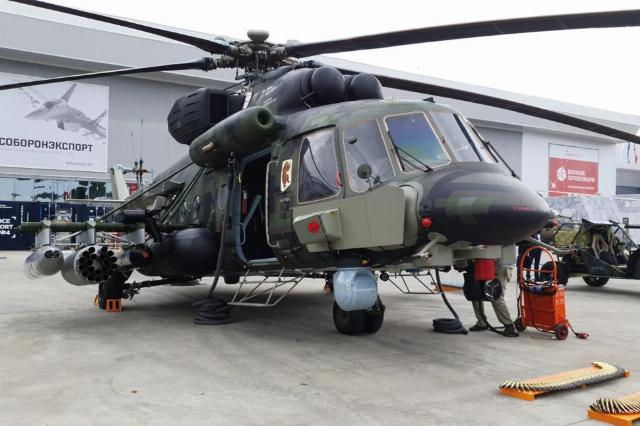
Mi-8AMTSh-VN
Image source: © Roman Azanov/ TASS
In 1968, the army version of the Mi-8 was adopted. The combat "eight" could transport troops, evacuate the wounded, and support units with fire. Later, specialized military modifications appeared — jammers, miners, tankers, amphibians. Today, upgraded versions of the combat vehicle are involved in a special military operation. For their high fighting qualities, the Ukrainian military nicknamed them the "rabid " eights". The modern version of the helicopter, the Mi-8AMTSh-VN, has enhanced protection, powerful weapons, and the latest avionics. In particular, it is used by Russian special forces .
Mi-26T2: the rotorcraft giant
Russian Helicopters Holding Company is the creator of the world's most heavy—duty Mi-26T2 transport helicopter. It is designed for the transportation of goods, evacuation and fire-fighting measures. The maximum take-off weight of the machine is 56 tons, while the helicopter is capable of transporting up to 20 tons of cargo in a transport cabin or on an external suspension. During evacuation, the Mi-26T2 can take 82 people on board with a crew of 3-5 people.
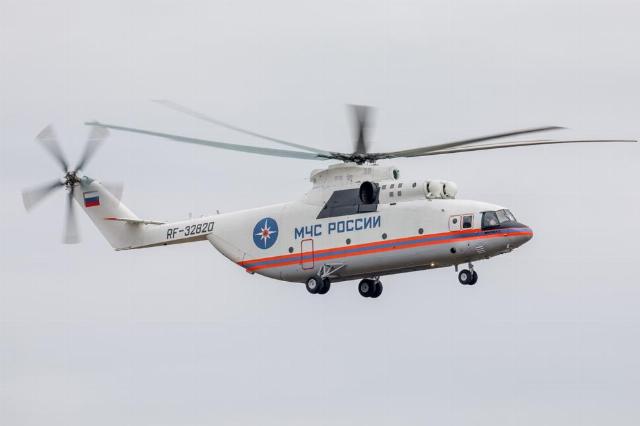
Mi-26T2
Image source: © Eric Romanenko/ TASS
Its predecessors of the Mi-26 family were used by the Soviet military contingent in Afghanistan, during the Chechen campaigns, combat operations in Nagorno-Karabakh, and numerous peacekeeping missions. Super-heavy helicopters took part in the aftermath of the Chernobyl nuclear power plant disaster.
The Mi-26 is indispensable for the delivery and installation of large—sized structures — power transmission towers, TV towers and repeaters, monuments - as a "flying crane". On an external suspension, it is capable of transporting even airplanes and helicopters, which are not inferior in size to its own.
The giant helicopter is in demand abroad. For example, the modification of the Mi-26TS was acquired by China. In the summer of 2016, one of the vehicles, together with another Russian helicopter, Ka-32A11BC, extinguished a large forest fire in Zhejiang Province, in a remote mountainous area. In addition, Venezuela bought the Mi-26T.
Ansat-M: small, but good
The Ansat helicopter family is the first fully designed and built in the post—Soviet history of Russia. The light multi-purpose helicopter was developed at the Kazan Helicopter Plant. Hence the name "Ansat": translated from Tatar, the word means "easy", "simple". The spacious cargo and passenger cabin can be quickly transformed for various applications — transportation of passengers, cargo, use as a flying ambulance . In 2019, a VIP version of the car in the style of the Aurus brand was introduced. In addition to the premium interior, the helicopter received improved vibration and noise protection.
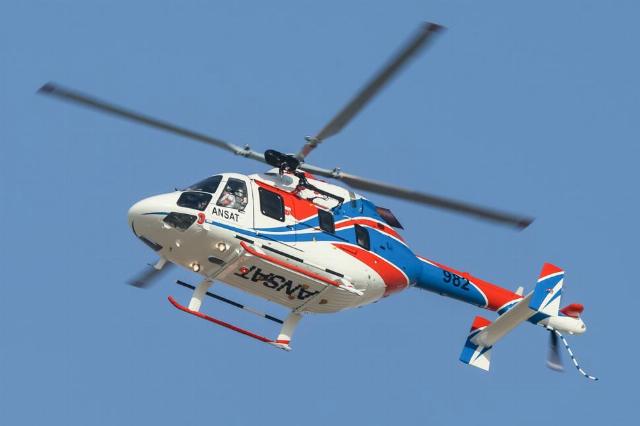
Ansat-M
Image source: © Marina Lystseva/ TASS
In December 2020, an upgraded version of the Ansat—M helicopter made its first flight. Compared with its predecessor, its range increased to 800 km, the share of composite materials in the structure increased to 35%, which allowed to reduce weight. The new on-board electronics allow the upgraded Ansat to fly even with zero visibility.
Foreign buyers became interested in the car. Thus, Zimbabwe received a batch of 18 sanitary "Ansats".
"There are a large number of potential customers for it, and we are conducting intensive negotiations," Denis Manturov, who served as Deputy Prime Minister and head of the Ministry of Industry and Trade of the Russian Federation, told about Ansat's export prospects at the Dubai Airshow International airshow. "And this is not only the Middle East, it is also Africa, where we have already started delivering this helicopter."
Victor Bodrov
